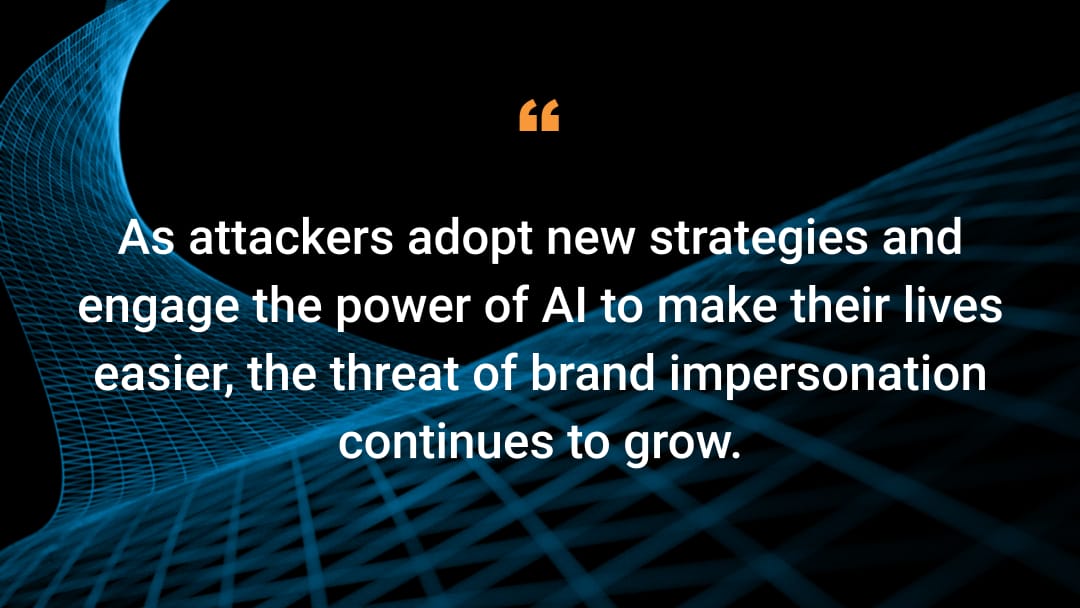As Phishing Websites Flourish, Brands Seek Protection from Impersonation

Brand impersonation attacks are on the rise, according to research by YouMail. For example, the Anti-Phishing Working Group’s Phishing Activity Trends Report, disclosed a record 1,270,883 phishing attacks in Q3 2022.
Companies spend billions of dollars establishing, promoting, and burnishing their brand. Yet, all the time, effort, and money invested in building trust with your customers can become just another area for attackers to exploit.
Consumer trust can make you vulnerable
According to Mimecast’s State of Brand Protection Report, 40% of consumers don’t hesitate to click on links in emails from their favorite brands. That makes your customers — and you — frighteningly susceptible to brand impersonation.
Those customers who purchase a fake item — that they think comes from you — may not come back. Research has found that, after buying a fake good online, 52% of U.S. consumers lost trust in the impersonated brand.
Considering how much it costs to earn that customer trust, losing it becomes incredibly costly. By some estimates, an organization’s brand can contribute up to 50% of its value.
Brand impersonation can be costly in more ways than one
Attackers may use fake websites to steal your customers’ user credentials and payment information (phishing schemes)
Attackers may create fake websites that mirror your own (seeking to profit from sales that are ultimately left unfulfilled), which can damage the customer relationship and devalue your product
Furthermore, reputational effects are not the only impacts on revenue. Brand impersonation can impact employee morale, catalyze customer churn, increase productivity losses, and eat up resources.
Spending to fight brand impersonation is on the rise
Unfortunately, phishing websites are easier and cheaper to build than ever — thanks in part to phishing as a service kits that sell for as little as $50 — which helps fuel the increase in attacks. As a result, we’re seeing an increase in spending on brand impersonation defense.
According to a Kaspersky study, 45% of small and medium-sized businesses (with 50 to 999 employees) and 47% of enterprises (businesses with more than 1,000 employees) surveyed said they considered customer phishing through brand impersonation a top concern. And security spending is expected to increase by up to 14% over the next three years.
How can security solutions prevent brand impersonation?
Enterprises seeking to protect their brand have some options when it comes to solutions. Ideally, they’ll choose a tool that continuously detects phishing sites across the internet and delivers actionable insights without forcing staff to waste time chasing down legitimate partner sites.
Akamai can provide a distinctive advantage with our edge network. More than 4,000 locations in 134 countries provide comprehensive data and intelligence feeds — including Akamai logs, DNS data, and third-party feeds — for the information that our customers need.
Useful insights
For example, the Akamai Security Intelligence Group has learned that, among the top 20 countries that host phishing websites, 72% of sites are in the United States, followed by Germany (5.3%), United Kingdom (3.6%), and Russia (3%).
Additionally, Akamai researchers noted that November was the most active month for brand impersonation attacks in 2022, at 202% of the average, and June was the lowest. That’s the kind of insight that can help determine how attackers are using logos, content, and images for brand impersonation and larger scale security attacks.
Discovery and mitigation
Akamai also offers website scanning and artificial intelligence (AI)-backed cybersquatting detection to discover the brand impersonation sites that are affecting your brand. Meanwhile, Akamai’s algorithms are preconfigured to deliver accuracy, minimize false positives, and facilitate administration.
Akamai also offers more advanced options that scan the internet for instances of attackers using typos, homophones, homoglyphs (an i that looks like an I or a 1, for example), and other URL permutations to siphon away traffic and customers.
It doesn’t stop at detection, either. Akamai Brand Protector also automates and tracks takedown requests with a third party provider..
Constant vigilance with Akamai
As attackers adopt new strategies and engage the power of AI to make their lives easier, the threat of brand impersonation continues to grow. Enterprises need to maintain constant vigilance with the support of a platform that provides comprehensive worldwide coverage.
Learn more
Learn more about Akamai Brand Protector and other products and capabilities that empower customers to provide consistent online experiences.


